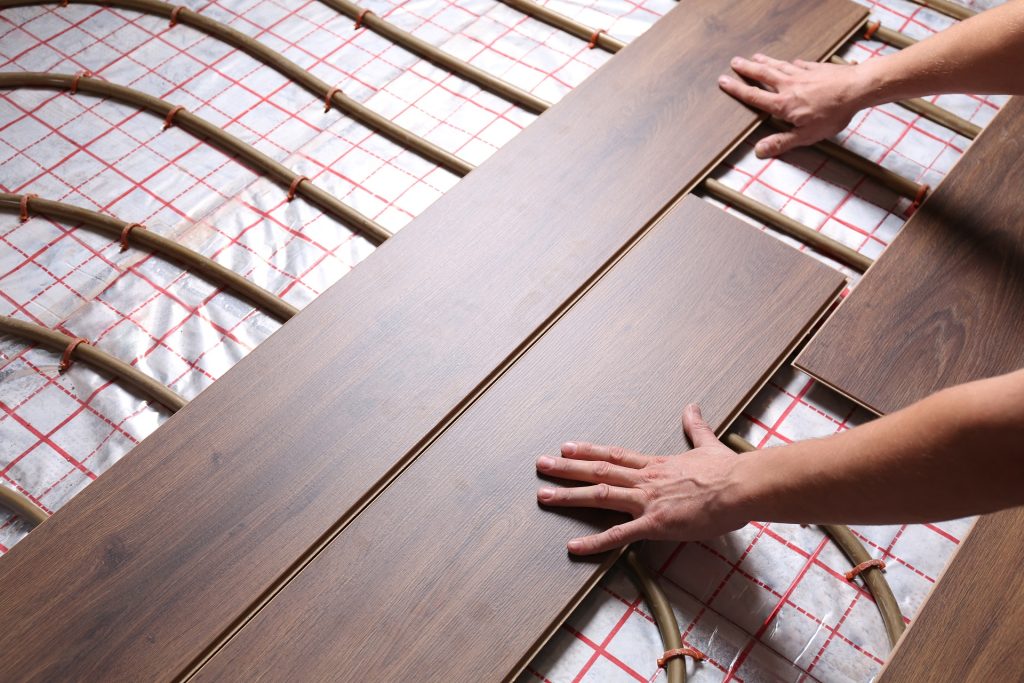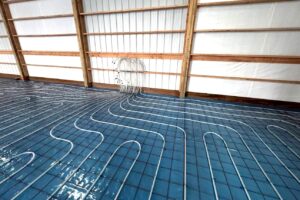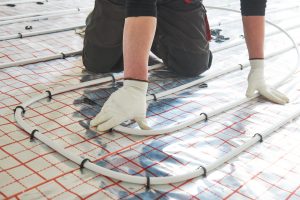As remote work becomes the standard for more and more of us, a new focus is emerging around improved overall quality in our home environments. This trend is moving energy-efficient solutions, such as radiant floor heating, front and center.
While hydronic radiant heating is a very old technology (and has been the main form of heating homes throughout Europe for decades), the U.S. has lagged in adopting it. While offering thermal comfort, hydronic radiant heating is also exceptionally energy-efficient and helps promote cleaner indoor air. Below, four reasons why radiant heat is a superior choice.
Improved Air Quality
In hydronic radiant heating, warm water flows through flexible plastic tubing embedded in a concrete slab or placed on top or underneath the subfloor. The warmth from the flowing water through the tubing radiates up from the floor. Because pumps move the water (instead of fans or blowers to push air), the system doesn’t circulate dust, allergens, or odors. Often, radiant heat is a welcome solution for people with severe allergies. Additionally, there’s no ductwork required.
A Quieter Environment
Most people with traditional HVAC systems are familiar with the loud sounds coming from their basements or attics when the heat turns on. Also, ductwork expands and contracts as the hot air blows through the system, and then cold air enters when the system is off.
Hydronic radiant floor heating is quiet as the water running through the tubing in the floors silently distributes warmth without noise. The mechanical parts are also just as quiet.
Except for occasional boiler maintenance, radiant heat systems are generally maintenance-free. However, traditional HVAC systems need regular air filters and furnace tune-ups that can drive up costs with technician visits and supplies.
Long-Term Energy Savings
Water has 3,500 times the capacity of air to transport energy, which means hydronic radiant heating is naturally much more energy-efficient. This is especially important because heating and electricity generation accounts for nearly 25% of all greenhouse gas emissions, per the EPA.
Radiant is also more energy-efficient because the heat stays near the floor, closer to where you need it. HVACs blow hot air into a room and quickly rises to the ceiling. Additionally, people are more comfortable with a radiant floor heating system at a lower thermostat setting, such as 68° F, than with a forced-air system, even at a higher thermostat setting such as 72°. Those four degrees can equal big energy bill differences.
The zone-based installation of these systems highlights separate thermostats for each radiant-heated space. Not only does this provide custom comfort control when people are in a space, but it also allows the heat to remain low in spaces that are not in use.
Overall Better Comfort
Radiant heat is so comfortable because it most closely aligns with how our bodies regulate temperature. As stated previously, when forced-air heat enters a room, it quickly heads to the ceiling, so people can’t keep consistent heat near their bodies. Radiant heating, however, provides a consistent, even comfort that stays near the floor at all times.
For these reasons and more, radiant heat is an excellent choice, saving significant amounts of money over time in luxury and more traditional homes alike. If you have questions about installation, cost, or anything else radiant heat-related in the Portland, Oregon area, call the team at The Earth Heating today at (503) 788-7777 to learn more about how we’ve helped Portland, Oregon homeowners upgrade their homes.




